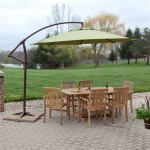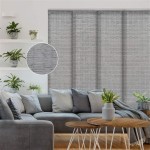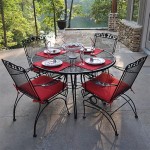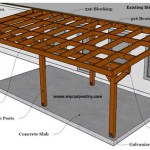Bringing The Charm Of the Past To Your Patios: A French-Inspired Transformation
The patio, a transitional space between the interior comfort of a home and the boundless outdoors, offers a unique opportunity to express personal style. For individuals with an appreciation for history and elegance, drawing inspiration from French design principles can imbue a patio with timeless charm. This article explores key elements and considerations for transforming a patio into a space reminiscent of classic French gardens and courtyards.
French patios, often characterized by their understated sophistication, prioritize symmetry, natural materials, and a harmonious blend of functionality and aesthetics. Unlike more flamboyant styles, French design emphasizes restrained elegance, focusing on quality craftsmanship and enduring appeal. Achieving this look requires careful planning and attention to detail, incorporating elements that evoke the atmosphere of a bygone era.
The selection of materials plays a crucial role in creating an authentic French-inspired patio. Natural stone, such as limestone or travertine, is a foundational element. These materials offer durability, a pleasing texture underfoot, and a neutral color palette that complements a variety of design schemes. Brick, particularly reclaimed brick with a weathered appearance, can also contribute to the overall aesthetic, adding warmth and a sense of history.
Beyond the hardscape, the choice of furniture is equally important. Wrought iron furniture, with its intricate details and classic silhouettes, is a hallmark of French design. Pieces with scrolled arms, curved backs, and a slightly distressed finish contribute to the authentic feel. Teak furniture, known for its durability and natural beauty, can also be incorporated, particularly for larger seating areas. Opting for neutral-colored cushions and upholstery, such as linen or canvas in shades of cream, beige, or gray, will further enhance the understated elegance of the space.
The incorporation of water features can significantly elevate the ambiance of a French-inspired patio. A small fountain, either freestanding or integrated into a wall, adds a soothing sound and visual interest. The sound of trickling water evokes a sense of tranquility and provides a focal point for the space. Consider a tiered fountain made of cast stone or a simple wall-mounted spout with a basin below. The design should complement the overall style of the patio, avoiding overly ornate or modern designs.
Importance of Symmetry and Balance in Design
Symmetry is a central tenet of French garden and patio design. Achieving a balanced layout creates a sense of order and visual harmony. This can be achieved through the placement of furniture, planters, and other decorative elements. For example, flanking a doorway or pathway with identical planters or benches creates a symmetrical arrangement that is visually pleasing. When arranging seating areas, consider mirroring elements on either side of a central focal point, such as a fireplace or a water feature. While strict symmetry may not always be possible or desirable, striving for a sense of visual balance is crucial for capturing the essence of French design.
The use of geometric shapes, such as squares, rectangles, and circles, further reinforces the sense of order and balance. Consider incorporating these shapes into the design of the patio itself, such as through the layout of paving stones or the shape of flower beds. This attention to detail contributes to the overall sense of refinement and sophistication that is characteristic of French design. Even in smaller patios, the principles of symmetry and balance can be applied to create a visually appealing and harmonious space.
A key aspect of creating symmetry is ensuring that the focal point is correctly positioned. Whether it's a large urn, a sculpture, or a significant piece of furniture, the focal point should act as the anchor for the rest of the design. Elements surrounding the focal point should be arranged in a way that enhances its prominence and contributes toward the overall balance of the area.
The concept of balance extends beyond the physical arrangement of objects. Consider the balance of colors, textures, and materials. The color palette should be cohesive and harmonious, with a limited number of dominant colors. The use of varying textures, such as the smooth surface of stone contrasted with the rough texture of brick, adds visual interest without disrupting the overall sense of balance. Combining different materials thoughtfully can introduce depth and complexity to the design.
Selecting Appropriate Plants and Landscaping
The selection of plants is crucial for creating a French-inspired patio. Unlike English gardens, which often feature a profusion of colorful flowers, French gardens tend to be more restrained, emphasizing greenery, structure, and fragrance. Boxwood hedges, neatly trimmed into geometric shapes, are a classic element. These hedges provide a sense of formality and structure, defining pathways, borders, and flower beds.
Roses, particularly fragrant varieties, are another essential element. Climbing roses, trained to grow along walls or trellises, add a romantic touch. Lavender, with its distinctive fragrance and delicate foliage, is also a popular choice. Plant lavender in pots or along borders to create a sensory experience. Other suitable plants include hydrangeas, which offer a variety of colors and textures, and herbs such as rosemary and thyme, which add fragrance and culinary utility.
The arrangement of plants should be carefully considered to maintain the overall sense of symmetry and balance. Plant identical specimens in pairs on either side of a pathway or doorway. Use planters of varying sizes to create visual interest, but ensure that the overall arrangement remains balanced. Avoid overcrowding plants, allowing each specimen to thrive and maintain its shape. Consider the mature size of plants when planning the layout to ensure that they do not overwhelm the space as they grow.
The use of topiary, the art of shaping plants into ornamental forms, is another hallmark of French gardens. Boxwood is commonly used for topiary, but other plants such as yew and privet can also be shaped into geometric forms. Topiary adds a touch of formality and elegance to the patio. Consider placing topiary specimens in pots or along pathways to create visual interest.
In larger patios, trees can be incorporated to provide shade and add vertical interest. Choose trees with a graceful form and delicate foliage, such as olive trees or crepe myrtles. These trees evoke the Mediterranean atmosphere that is often associated with French design. Ensure that the trees are planted in a location where they will receive adequate sunlight and have enough space to grow without overcrowding other plants.
The Role of Color and Lighting in Creating Ambiance
The color palette for a French-inspired patio should be restrained and harmonious. Neutral colors, such as cream, beige, gray, and white, dominate the design. These colors provide a backdrop for the furniture, plants, and other decorative elements. Accents of color can be introduced through flowers, cushions, and other accessories. However, these accents should be used sparingly to avoid overwhelming the overall aesthetic.
Soft, muted colors are preferred over bright, vibrant hues. Pastel shades, such as lavender, rose, and pale blue, can add a touch of romance and elegance. However, these colors should be used sparingly and in combination with neutral tones. Avoid using overly bold or saturated colors, which can detract from the overall sense of sophistication.
The quality of light can significantly impact the ambiance of a patio. Natural light is always preferred, but artificial lighting can be used to enhance the space during the evening hours. Soft, warm lighting is ideal for creating a relaxed and inviting atmosphere. Avoid using harsh, bright lights, which can be jarring and unappealing.
The selection of light fixtures should complement the overall style of the patio. Wrought iron lanterns, with their intricate details and classic silhouettes, are a popular choice. String lights, hung from trees or pergolas, can add a festive touch. Consider using candles, either in lanterns or on tabletops, to create a romantic and intimate atmosphere. Solar lights can also be used to illuminate pathways and highlight specific features of the garden.
The placement of lights should be carefully considered to create a balanced and harmonious effect. Avoid placing lights in locations where they will shine directly into people's eyes. Instead, focus on using lights to illuminate pathways, highlight architectural features, and create a soft, ambient glow. Consider using dimmer switches to adjust the intensity of the lights to suit different occasions. Lighting should enhance the design and not be the main focus of the area.
By carefully considering these elements, individuals can transform their patios into charming spaces that evoke the timeless elegance of French design. This requires a commitment to quality craftsmanship, attention to detail, and a deep appreciation for the principles of symmetry, balance, and understated sophistication. The resulting patio will provide a serene and inviting retreat, where individuals can relax, entertain, and enjoy the beauty of the outdoors.

Modern Farmhouse Style Summer 2025 Embrace Your Place

Refresh Your Porch Or Patio In Just One Week French Ethereal
:strip_icc()/101758428-b76c5a7f789445ee96011c8c16ad2c0d.jpg?strip=all)
11 Tuscan Decor Ideas That Bring Rustic Charm To Your Home

26 Patio Shade Ideas To Help You Stay Cool Timbertech

Ancient Fully Red 13th Century Medieval Village House With Garden Patio Issigeac Vrbo

Petit Trois L Original Restaurant Los Angeles Ca Opentable

City Chefs Head To The Hudson Valley Lured By Fresh Ingredients New York Times

Meet In Paris Culver City Restaurant Reviews Photos Reservations Tripadvisor
Patio Gardening Ideas Ways To Bring More Flowers And Foliage Into Your Space

7 Unique Backyard Patio Ideas On A Budget
Related Posts








